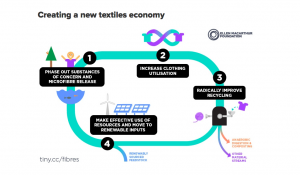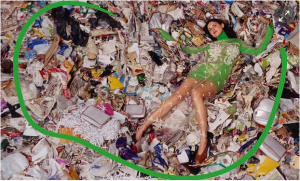The New Textiles Economy


By Anya Ferring
Yesterday the Ellen MacArthur Foundation released a new report, “A new textiles economy: Redesigning fashion’s future in London.” The launch was co-hosted by Stella McCartney whose Winter 2017 ad campaign compares two different disposal sites, located on the eastern coast of Scotland. One image shows a model shot against a backdrop of “clean waste” that will be shipped to a recycling center, which is contrasted by a second photograph of a trash-packed landfill.
The MacArthur report calls for an overhaul of the wastefulness of the fashion industry and outlines certain steps to achieve it. According to the report, today’s textile industry is operating on an “outdated linear, take-make-dispose model” that is the root cause of many environmental impacts and substantial economic value loss. Currently the throwaway nature of fashion has created a business that creates greenhouse emissions of 1.2 billion tons a year – larger than that of international flights and shipping combined. If nothing changes, by 2050 the fashion industry will use up a quarter of the world’s carbon budget. As well as being wasteful, the industry is polluting: clothes release half a million tons of microfibers into the ocean every year, equivalent to more than 50 billion plastic bottles. Microfibers are likely impossible to clean up and can enter food chains.
The report outlines a vision and sets out ambitions and actions – based on the principles of a circular economy – to design out negative impacts and capture a USD 500 billion economic opportunity by truly transforming the way clothes are designed, sold, and used. In this new model, clothes, fabric, and fibers re-enter the economy after use and never end up as waste. This vision relies on four main ambitions:
- Phase out toxic substances and microfibers, by aligning industry efforts and coordinate innovation to create safe material cycles.
- Transform the way clothes are designed, sold and used to break free from their increasingly disposable nature, by scaling up clothing rentals; making durability more attractive; and increasing clothing utilization through brand commitments and policy.
- Radically improve recycling by transforming clothing design, collection and reprocessing; pursuing innovation to improve the economics and quality of recycling; stimulating demand for recycling materials; and implementing clothing collection at scale.
- Make effective use of resources and move to renewable inputs.
Creating a new textiles economy sets a new level of ambition for the fashion industry, and will require an unprecedented scale and depth of collaboration. So far over 40 industry leaders have endorsed the new vision and report, and now the Ellen MacArthur Foundation is calling on the entire industry to rally behind this new vision and to launch a new wave of cross-industry collaboration and innovation to achieve it.